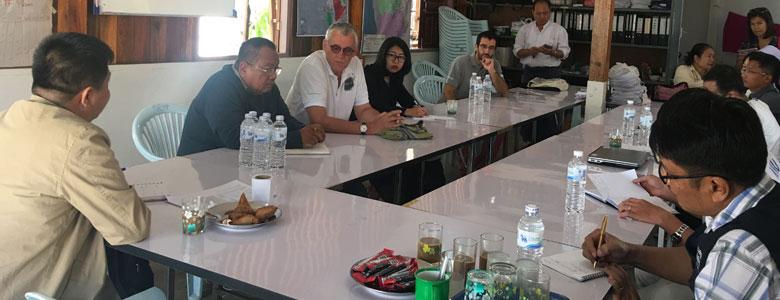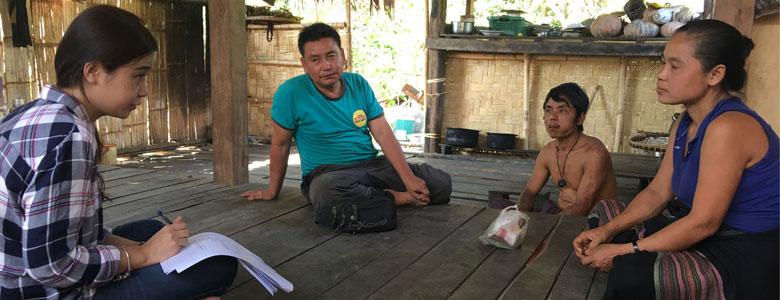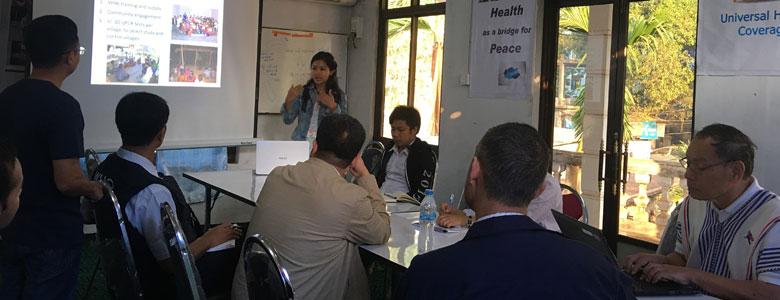PR-UNOPS RAIအဖွဲ့သည်၂၀၁၇ ခုနှစ်ဖေဖော်ဝါရီလ(၁၆)ရက်မှ (၁၉) ရက်နေ့အထိ အမျိုးသားငှက်ဖျားရောဂါတိုက်ဖျက်ရေးစီမံကိန်း(Nationnal Malaria Control Programme – NMCP) နှင့် ကမ္ဘာ့ကျန်းမာရေးအဖွဲ့(World Health Organization – WHO )တို့နှင့်အတူပူးတွဲကွင်းဆင်း လေ့လာရေးခရီးသွားရောက်ခဲ့သည်။ဒေသတွင်းအာတီမီစနင်းဆေးယဉ်ပါးမူကနဦးစီမံချက်၏ နိုင်ငံ အချင်းချင်းပူးပေါင်းဆောင်ရွက်မူအစီအစဉ်အောက်ရှိ(Shoklo Malaria Research Unit – SMRU)နှင့် (Medical Action Myanmar – MAM )တို့၏စီမံချက်အကောင်အထည်ဖေါ်သည့်ဒေသများသို့ သွားရောက်ခဲ့ခြင်းဖြစ်သည်။
PR-UNOPS RAIအဖွဲ့သည်၂၀၁၇ ခုနှစ်ဖေဖော်ဝါရီလ(၁၆)ရက်မှ (၁၉) ရက်နေ့အထိ အမျိုးသားငှက်ဖျားရောဂါတိုက်ဖျက်ရေးစီမံကိန်း(Nationnal Malaria Control Programme – NMCP) နှင့် ကမ္ဘာ့ကျန်းမာရေးအဖွဲ့(World Health Organization – WHO )တို့နှင့်အတူပူးတွဲကွင်းဆင်း လေ့လာရေးခရီးသွားရောက်ခဲ့သည်။ဒေသတွင်းအာတီမီစနင်းဆေးယဉ်ပါးမူကနဦးစီမံချက်၏ နိုင်ငံ အချင်းချင်းပူးပေါင်းဆောင်ရွက်မူအစီအစဉ်အောက်ရှိ(Shoklo Malaria Research Unit – SMRU)နှင့် (Medical Action Myanmar – MAM )တို့၏စီမံချက်အကောင်အထည်ဖေါ်သည့်ဒေသများသို့ သွားရောက်ခဲ့ခြင်းဖြစ်သည်။
လေ့လာရေးအဖွဲ့သည်ကရင်ပြည်နယ်ရှိဝေးလံခေါင်ဖျားဒေသမှရွာလေးရွာသို့သွားရောက်ခဲ့ကြသည်။ရွာနှစ်ရွာမှာအုပ်စုလိုက်ငှက်ဖျားဆေးတိုက်ကျွေးခြင်း(mass drug administration –MDA)ကိုရရှိထားပြီးကျန်နှစ်ရွာမှာမရရှိသေးပေ။သူတို့အဖွဲ့သည်ငှက်ဖျားစခန်းများကို ကြည့်ရှုလေ့လာခြင်း၊ငှက်ဖျားစခန်းရှိလုပ်သားများနှင့်တွေ့ဆုံမေးမြန်းခြင်းနှင့်လူနာမှတ်တမ်းတင်ခြင်း အချက်အလက်များကိုစစ်ဆေးခြင်းတို့ကိုပြုလုပ်ခဲ့ကြသည်။MDAရရှိထားသောရွာနှစ်ရွာတွင်ရွာသူရွာသား များ၏ငှက်ဖျားဆိုင်ရာဗဟုသုတ၊ရောဂါကာကွယ်ရေးလုပ်ငန်းများကိုလေ့လာခဲ့သည့်အပြင်၊အထူးအရေးပါသည့်သူတို့၏အမြင်သဘောထားများ၊အတွေ့အကြုံများနှင့်MDAကိုလက်ခံကြိုဆိုမှုတို့ကိုသိရှိနိုင်ရန် စနစ်တကျပြုစုထားသောစစ်တမ်းမေးခွန်းလွှာများကိုအသုံးပြု၍ဒေသခံများနှင့်တွေ့ဆုံမေးမြန်းခြင်းများပြု လုပ်ခဲ့ကြသည်။
The team found that all malaria posts visited were functioning well and that community acceptance of MDA was good. They were informed that the number of malaria cases had been declining in both MDA and non-MDA villages. However, the number of cases has been gradually increasing again since MDA was completed, even in isolated villages with less population movement.
The team provided recommendations for applying MDA interventions to large population groups in Myanmar. While MDA is an effective intervention in the elimination phase, MDA interventions could be limited to areas with less population movement and should always be accompanied by community engagement and follow-up. They concluded that to reduce malaria burden it is critical to have well-functioning malaria posts with volunteers, given the diverse geographic nature and dynamic environmental and demographic changes in Myanmar. To support their findings, they suggested that more time could be allocated to future review missions to increase the number of villages visited.







